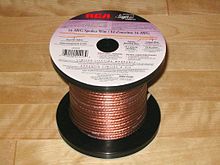Loudspeaker line
A loudspeaker cable , also known colloquially as a “ loudspeaker cable ”, is usually a two-core electrical line that connects the loudspeaker connections of an audio amplifier with a loudspeaker box. With the low-frequency audio signal, it transmits the electrical power required to control the loudspeakers .
material
The cores of loudspeaker lines usually consist of insulated copper wire . Aluminum (see also copper-clad aluminum ) or various precious metals and alloys are also used as conductor material . Aluminum is less suitable because it is more prone to wire breaks and has an electrical resistivity that is around 50% higher . Precious metals are also used in loudspeaker cables, although a benefit with regard to the sound result has not been proven.
In cables with a round profile, the cores are usually twisted together , which reduces the radiation of magnetic fields.
If the two insulated wires are also surrounded by an outer jacket, one speaks of an electrical line or, in this case, a loudspeaker line.
Voltage and current
Depending on the power transmitted, dangerously high alternating voltage can be present on a loudspeaker line . Services are quite at 2 in the event equipment kW to a speaker with 8 Ω transferred, which a voltage of 125 V corresponds. Touching uninsulated cable ends and connections can then lead to an electrical accident .
However, with the much lower power levels customary in hi-fi technology, touching loudspeaker lines is usually not dangerous.
Line cross-section
For the home hi-fi or home cinema system, twin cores made of stranded copper with core cross-sections between 0.75 mm² for short and up to 4 mm² for longer cable routes (up to about 20 m) are used. Higher cross-sections offer an even lower resistance, but this no longer has a noticeable effect on the sound.
In professional event technology, cross-sections of 2.5 mm² are the minimum, depending on the required performance, cross-sections of up to 10 mm² are used.
End termination
In the home, loudspeaker lines are often connected directly to amplifiers and loudspeaker boxes without terminating with pressure or screw terminals . The open strand ends can be protected with wire end sleeves or cable lugs . Spring connectors (coll. "Banana plugs") and DIN plugs (coll. "Semicolon plugs ") are also often used, the former often being combined with screw terminals.
In the professional sector, XLR , jack and Speakon plugs are used as cable terminations.
Loudspeaker line with banana plugs
XLR plug with loudspeaker line
The Speakon system is the standard connection in professional public address technology
Homopolar connection
If several loudspeakers are operated, they must be connected in the same direction, otherwise the sound signal will be partially canceled and the localization of the phantom sound sources impaired (see also Out of Phase Stereo ).
For homopolar connections, the poles of amplifier outputs and loudspeaker connections are marked as plus and minus , although alternating voltage is transmitted; therefore, there is no permanent damage from mixed up connections. Plus and minus are defined on the loudspeaker in such a way that when the plus terminal becomes positive compared to the minus terminal, the loudspeaker membrane moves outwards - i.e. a sound pressure maximum is generated.
The positive pole of the connections is usually marked red and the negative pole black. As a rule, the wire insulation on the loudspeaker line is marked differently (color, longitudinal corrugation, lettering); the wire marked in this way is usually used as a plus wire.
Audio amplifiers and AV receivers with an automatic calibration system recognize that the connection wires have been mixed up and prompt you to correct them.
Special cable types
Constructions with special properties are advertised by numerous manufacturers, such as
- very large conductor cross-section;
- especially pure copper (so-called OFC - Oxygen Free Copper);
- exotic materials for conductors, insulation and contacts;
- special pipe geometries;
- the so-called burn-in;
- Treatment of the material on the basis of pseudoscientific ideas.
Such cables have a more attractive appearance and can offer mechanical advantages (for example in terms of flexibility). As far as the quality of the audio playback is concerned, however, scientific studies have shown that they are not superior to a “normal”, technically flawless, double-core copper braid with cross-sections that are adequate for distance. The advertised advantages are purely subjective or pseudoscientific or are based on the inappropriate transfer of knowledge from high-frequency technology to the (low-frequency) audio signal. There is neither verifiable experimental evidence nor well-founded theoretical deductions.
See also
- Bi-wiring , a type of connection with separate cables for the bass and treble ranges
Individual evidence
- ↑ Copper in electrical engineering - cables and wires (Deutsches Kupfer-Institut eV) ( page no longer available , search in web archives ) Info: The link was automatically marked as defective. Please check the link according to the instructions and then remove this notice. (PDF; 635 kB)
- ↑ a b c Fred E. Davis Effects of Cable, Loudspeaker, and Amplifier Interactions , Journal of the Audio Engineering Society, Issue 39, No. 6, June 1991 (PDF; 856 kB)
- ^ RA Greiner: Amplifier-Loudspeaker Interfacing, Journal of the Audio Engineering Society, Volume 28, Issue 5, Pages 310-315, May 1980
- ^ Thomas Görne Tontechnik Carl Hanser Verlag, Munich 2008, ISBN 978-3-446-41591-1 , p. 16, p. 205
- ↑ Floyd E. Toole: Sound Reproduction Loudspeakers and Rooms , Focal Press Elsevier, Burlington 2008, ISBN 978-0-240-52009-4 , pp. 421-425
literature
- Andreas Friesecke: Die Audioenzyklopädie KG Saur Verlag, Munich 2007, ISBN 978-3-598-11774-9
- Electrical engineering - EUROPA teaching material, ISBN 978-3-8085-3190-7
- Hösl, Ayx, Bush: The proper electrical installation , Hüthig Verlag, ISBN 978-3-7785-4049-7






